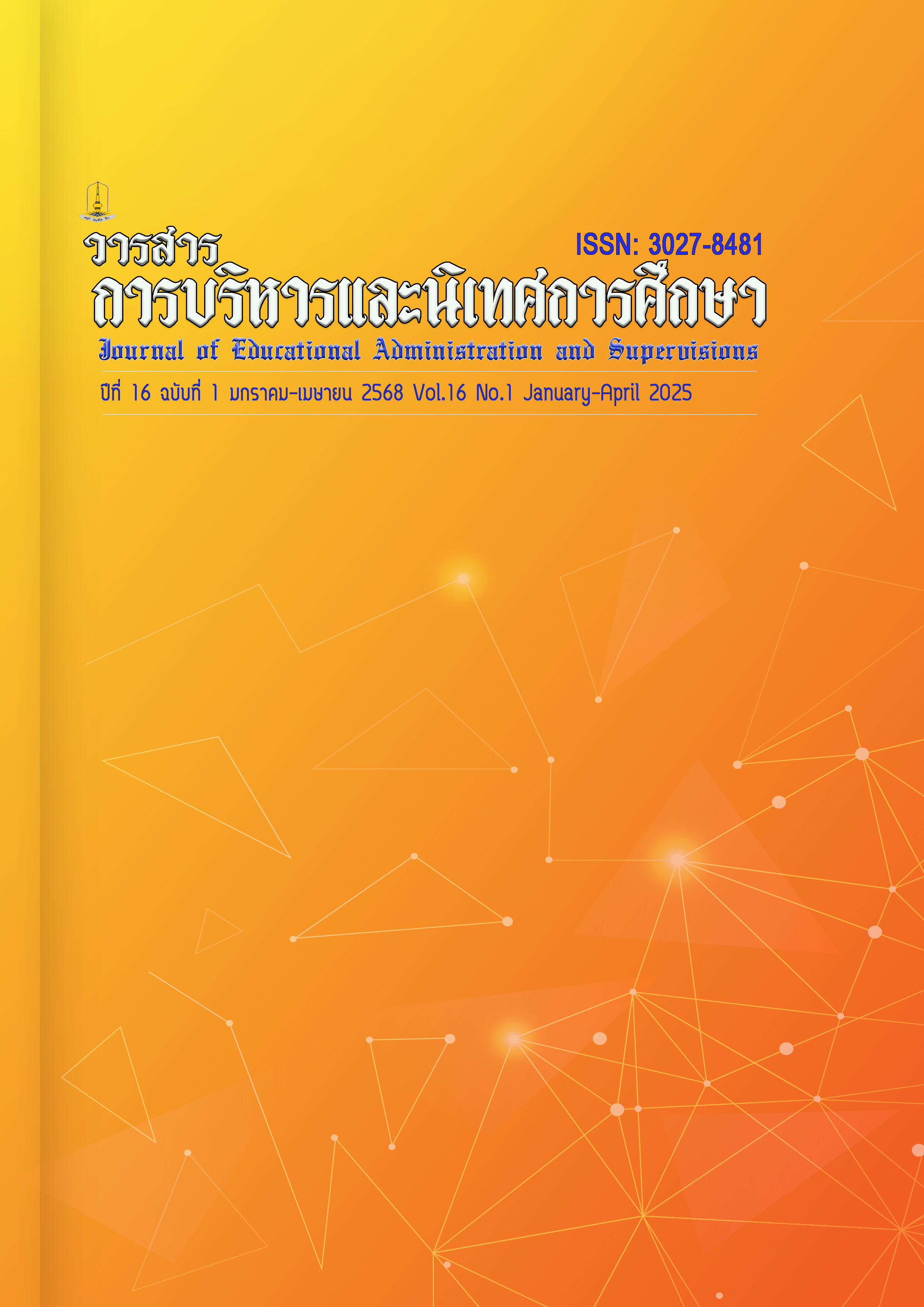Promoting Lifelong Learning in Educational Institutions under Songkhla Provincial Office of Learning Encouragement
Main Article Content
Abstract
This research aimed to 1) study the promotion of lifelong learning, 2) compare the promotion of lifelong learning, and 3) study the approach to promoting lifelong learning. The sample group used in the research was 184 teachers under the Office of the Provincial Learning Promotion in Songkhla Province. The sample group was determined from the Krejcie and Morgan (1970) sample size determination table and stratified random sampling according to the size of the educational institution. Then, simple random sampling was used by drawing lots. The informants from the interviews were 5 educational institution administrators who had worked as administrators in the district level learning promotion centers under the Office of the Provincial Learning Promotion in Songkhla Province for no less than 5 years or had a professional status of no less than a specialist. The research instrument was a 5-level rating scale questionnaire. The reliability of the questionnaire was 0.966. The statistics used for data analysis were frequency, percentage, mean, standard deviation, t-test (Independent t-test), F-test, and pairwise comparison of means. In case the F-test is statistically significant by the Least Significant Difference (LSD) method.
The research results found that 1) the promotion of lifelong learning was at a high level overall. When considering each aspect, the aspect with the highest average value was the development of learning management personnel, followed by diverse learning management, learning society creation, participation, and information technology use. 2) The promotion of lifelong learning classified by work experience and school size variables, it was found that overall, there was no difference. When considering each aspect, it was found that diverse learning management had a statistically significant difference at the .05 level. 3) the guidelines for the promotion of lifelong learning in educational institutions consisted of 1) Promoting collaboration from all sectors including administrators, teachers, personnel, students, communities and network partners 2) being a center for coordination and development of learning resource support systems 3) using technology in teaching and learning management and distributing learning opportunities 4) developing an environment and culture conducive to learning 5) creating learning approaches and formats that respond to needs, are flexible and easily accessible 6) developing personnel to have skills and knowledge that are up-to-date and meet the needs of learners.
Downloads
Article Details

This work is licensed under a Creative Commons Attribution-NonCommercial-NoDerivatives 4.0 International License.
References
กรมส่งเสริมการเรียนรู้. (2567). แผนปฏิบัติราชการประจำปีงบประมาณ พ.ศ. 2567 [เอกสาร ไม่ได้ตีพิมพ์].กรมส่งเสริมการเรียนรู้.
เขนย นามชุ่ม. (2561). การปรับเปลี่ยนภารกิจของสำนักงานส่งเสริมการศึกษานอกระบบและการศึกษาตามอัธยาศัยเพื่อให้สอดคล้องกับแนวคิดในการศึกษาตลอดชีวิต [วิทยานิพนธ์ปริญญามหาบัณฑิต ไม่ได้ตีพิมพ์]. มหาวิทยาลัยธรรมศาสตร์. https://digital.library.tu.ac.th/tu_dc/frontend/Info/item/dc:165894
จุรีพร นิลแก้ว และสมใจ สืบเสาะ. (2566). บทบาทของผู้บริหารในการส่งเสริมการใช้นวัตกรรมและเทคโนโลยีสารสนเทศด้านการจัดการเรียนรู้ของครูสังกัดสำนักงานเขตพื้นที่การศึกษาประถมศึกษาชุมพร เขต 1. วารสารนวัตกรรมการศึกษาและการวิจัย, 7(1), 83–98. https://so03.tci-thaijo.org/index.php/vjeir/article/view/258362/177107
จักรวุฒิ ชนะพันธ์, กฤษดา ผ่องพิทยา, วัลลภา อารีรัตน์, และมนสิช สิทธิสมบูรณ์ (2559). รูปแบบการส่งเสริมการเรียนรู้ตลอดชีวิตของสำนักงานส่งเสริมการศึกษานอกระบบและการศึกษาตามอัธยาศัยจังหวัดชัยภูมิ. วารสารบริหารการศึกษา มหาวิทยาลัยขอนแก่น, 11(2), 1-9. https://so02.tci-thaijo.org/index.php/EDMKKU/article/view/48138
เบญจพร สุคนธร. (2565). บทบาทของผู้บูริหารสถานศึกษาในการส่งเสริมการจดัการเรียนการสอนออนไลน์ สังกัดสำนักงานเขตพื้นที่การศึกษามัธยมศึกษา กรุงเทพมหานคร เขต 2. วารสารบริหารการศึกษา มศว, 19(36), 52-64 https://ejournals.swu.ac.th/index.php/EAJ/article/view/14791/11996
ปิยาภรณ์ พูลชัย. (2565). บทบาทของผู้บริหารสถานศึกษาในการส่งเสริมการจัดการเรียนการสอนที่เน้นผู้เรียนเป็นสำคัญตามความคิดเห็นของครูผู้สอน สังกัดสำนักงานเขตพื้นที่การศึกษาประถมศึกษาจันทบุรี [วิทยานิพนธ์ปริญญามหาบัณฑิต, มหาวิทยาลัยราชภัฏรำไพพรรณี]. https://etheses.rbru.ac.th/showthesis.php?theid=456&group=20
พระราชบัญญัติส่งเสริมการเรียนรู้ พ.ศ.2566. (2566,19 มีนาคม). ราชกิจจานุเบกษา. เล่ม 140 ตอนที่ 20 ก. หน้า 60-66.
พิทักษ์ พันธุวาป. (2562). ภาวะผู้นำทางวิชาการในศตวรรษที่ 21 ของผู้บริหารสถานศึกษา สังกัดสำนักงานเขตพื้นที่การศึกษามัธยมศึกษา เขต 20 [การศึกษาค้นคว้าด้วยตนเองปริญญามหาบัณฑิต ไม่ได้ตีพิมพ์]. มหาวิทยาลัยสุโขทัยธรรมาธิราช. https://ir.stou.ac.th/handle/123456789/4625
พัชราภา ตันติชูเวช (2559). แนวทางการจัดการศึกษาสำหรับเด็กและเยาวชนนอกระบบการศึกษา กรณีศึกษาจังหวัดตาก [รายงานการวิจัย ไม่ได้ตีพิมพ์]. มหาวิทยาลัยธุรกิจบัณฑิตย์. https://www.dpu.ac.th/dpurdi/upload/public/g4hxlpif3q8gww4og.pdf
วัชรพงศ์พันธุ์ อุปนันท์, วีระยุทธ ชาตะกาญจน์, และวณิชชากร พงศ์ทัศนา. (2564). รูปแบบการส่งเสริมการเรียนรู้ตลอดชีวิตในยุคดิจิทัลของสถานศึกษา สังกัดสำนักงานส่งเสริมการศึกษานอกระบบ และการศึกษาตามอัธยาศัยในอนาคต. วารสารสังคมศาสตร์และมานุษยวิทยาเชิงพุทธ, 6(10), 165–181. https://so04.tci-thaijo.org/index.php/JSBA/article/view/253977
ศักรินทร์ ชนประชา. (2562). การศึกษาตลอดชีวิต. วารสาร AL-NUR บัณฑิตวิทยาลัย, 14(26), 159–175. https://so01.tci-thaijo.org/index.php/NUR_YIU/article/view/137662
สํานักงานเลขาธิการสภาการศึกษา กระทรวงศึกษาธิการ. (2564). ดัชนีการศึกษาเพื่อการเรียนรู้ตลอดชีวิตของประเทศ ไทย พ.ศ. 2563. ทริปเพิ้ล กรุ๊ป จำกัด.
สำนักงานส่งเสริมการเรียนรู้ประจำจังหวัดสงขลา. (2567). แผนปฏิบัติการประจำปีงบประมาณ พ.ศ.2567 [เอกสาร ไม่ได้ตีพิมพ์]. สำนักงานส่งเสริมการเรียนรู้ประจำจังหวัดสงขลา.
สำนักงานสภานโยบายการอุดมศึกษา วิทยาศาสตร์วิจัยและนวัตกรรมแห่งชาติ. (2563). การส่งเสริมการเรียนรู้ตลอดชีวิต (Lifelong learning) เพื่อรองรับการพลิกโฉมฉับพลันและวิกฤตการณ์โลก. พริ้นเอเบิ้ล จำกัด.
สิตาภา เกื้อคลัง. (2561). องค์ประกอบและแนวทางการส่งเสริมการจัดการเรียนรู้ตลอดชีวิตของ กศน. ตำบล [วิทยานิพนธ์ปริญญาดุษฎีบัณฑิต, มหาวิทยาลัยศิลปากร]. http://ithesis-ir.su.ac.th/dspace/bitstream/123456789/2386/1/56251803.pdf
อติพร เกิดเรือง. (2565). การจัดการการเรียนรู้ตลอดชีวิตเพื่อพัฒนาคุณลักษณะผู้เรียนไทยยุค 4.0. วารสารสังคมศาสตร์และมานุษยวิทยาเชิงพุทธ, 7(2), 164–185. https://so04.tci-thaijo.org/index.php/JSBA/article/view/255709
อรทัย เกตุเผือก, สถาพร สังข์ขาวสุทธิรักษ์, และบรรจงเจริญสุข. (2564). การพัฒนาบุคลากรในการจัดกิจกรรม การเรียนรู้แบบบูรณาการของศูนย์การศึกษานอกระบบและการศึกษาตามอัธยาศัยอำเภอพุนพิน สำนักงานส่งเสริมการศึกษานอกระบบและการศึกษาตามอัธยาศัยจังหวัดสุราษฎร์ธานี [การศึกษาค้นคว้าด้วยตนเองปริญญามหาบัณฑิต ไม่ได้ตีพิมพ์]. มหาวิทยาลัยราชภัฏสุราษฎร์ธานี.
Cronbach, L. J. (1990). Essentials of psychological testing (5thed.). Harper Collins Publishers.
Krejcie, R. V. & Morgan, D. W. (1970). Determining sample size for research activities. ducational and psychological measurement, 30(3), 607-610. https://doi.org/10.1177/001316447003000308


